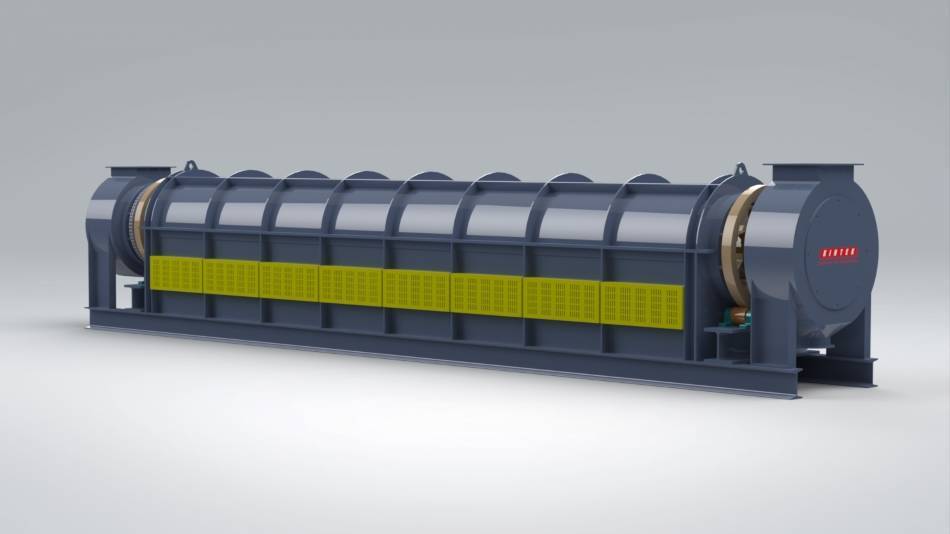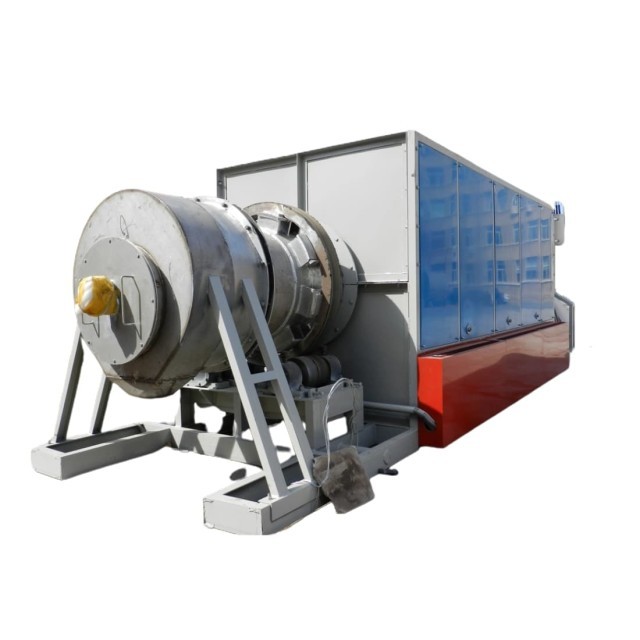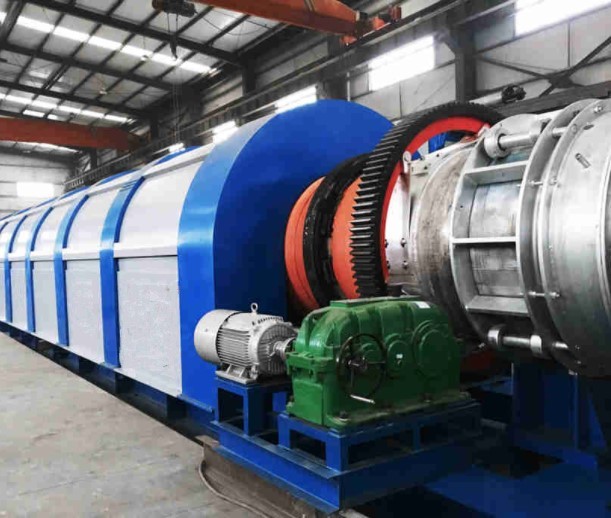Table of Contents
Introduction to Rotary Furnaces
Rotary furnaces are continuous thermal systems that revolutionize advanced materials processing. They utilize multiple thermal control zones to subject process materials to precise heating, ensuring uniform temperature distribution and efficient energy utilization. Their versatility extends to a wide range of applications, including heat treatment of metals and ceramics, sintering of advanced materials, and chemical vapor deposition. As the backbone of modern materials processing, rotary furnaces empower industries to achieve exceptional material properties and drive innovation across diverse sectors.
Working Principle of Rotary Furnaces
Rotary furnaces are indispensable instruments for advanced materials processing, offering unique advantages in various industries. They employ a sophisticated heat transfer mechanism that ensures uniform heating and efficient energy utilization.

Indirect Heat Transfer
Unlike direct-fired furnaces, rotary furnaces employ an indirect heat transfer method. The heat source is positioned external to the rotating tube containing the material being processed. This arrangement prevents direct contact between the heat source and the material, minimizing contamination and ensuring precise temperature control.
Heat Transfer Mechanism
The heat from the external source is transferred to the rotating tube, which then acts as a heat exchanger. The rotating motion of the tube distributes heat evenly throughout the material, eliminating temperature gradients and ensuring uniform processing.
Continuous Operation
Rotary furnaces are designed for continuous operation, allowing for uninterrupted processing of materials. The material is continuously fed into the furnace at one end and discharged at the other, enabling high throughput and efficient production.
Customizable Heating Zones
Rotary furnaces can be equipped with multiple heating zones, each with its own temperature control system. This flexibility allows for tailored heating profiles, accommodating different materials and process requirements.
Advantages of Rotary Furnaces
- Uniform Heating: The indirect heat transfer and rotating motion ensure uniform heating throughout the material, resulting in consistent results.
- Energy Efficiency: The efficient heat transfer mechanism minimizes energy loss, reducing operating costs.
- Versatile Applications: Rotary furnaces can process a wide range of materials, including powders, granules, and solids.
- Continuous Operation: The continuous operation allows for high throughput and efficient production.
- Customizable Heating Zones: Multiple heating zones enable tailored heating profiles, meeting specific process requirements.
Applications of Rotary Furnaces
Rotary furnaces play a crucial role in various scientific and industrial processes, particularly in material science and geology. These versatile furnaces offer precise temperature control and gas composition adjustment, making them ideal for a wide range of applications.
Material Synthesis
Rotary furnaces are extensively used for the synthesis of various advanced materials. The controlled atmosphere and temperature conditions allow researchers to tailor the properties of materials, such as:
- Catalysts: Rotary furnaces enable the synthesis of highly active and selective catalysts used in chemical processes.
- Pigments for Paints: These furnaces facilitate the production of pigments with specific color and durability characteristics.
- Calcination of Oil Shale: Rotary furnaces are employed to heat oil shale to release hydrocarbons and other organic compounds.
Metallurgical Applications
In the metallurgical industry, rotary furnaces are utilized for:
- Heat Treatment of Metals and Ceramics: Controlled heating and cooling cycles enhance the mechanical properties and microstructure of metals and ceramics.
- Sintering of Advanced Materials: Rotary furnaces facilitate the bonding of powdered materials into dense, high-strength components.
- Doping of Ceramics with Rare Earth Metals: These furnaces enable the incorporation of rare earth metals into ceramics, improving their electrical and optical properties.

Environmental Applications
Rotary furnaces are also used in environmental processes, such as:
- Incineration of Waste Materials: Rotary kilns are employed to destroy hazardous waste materials, reducing their environmental impact.
- Desorption of Soil Contaminants: Rotary furnaces can help remove pollutants from contaminated soil, restoring its quality.
- Upgrading of Phosphate Ores: Rotary furnaces are used to enhance the purity of phosphate ores, making them suitable for fertilizer production.
Other Applications
Beyond the aforementioned applications, rotary furnaces are utilized in a diverse range of industries, including:
- Plastics Processing
- Ceramics Processing
- Activated Coal Regeneration
- Lignite Degasification
- Scrap Tyre Recycling
- Sewage Sludge Disposal
- Waste Wood Recycling
Rotary furnaces continue to find new applications in various fields, contributing to advancements in material science, environmental protection, and industrial processes.
Advanced Mixing and Conveying Technologies in Rotary Furnaces
Mixing and conveying technologies play a crucial role in enhancing the performance of rotary furnaces, particularly for materials with specific processing requirements. By optimizing these technologies, engineers can improve material processing efficiency, reduce energy consumption, and tailor furnaces to specific applications.
Improved Mixing
Advanced mixing technologies can significantly increase the volume utilization of rotary furnaces. This is especially important for processes where reaction time is limited by heat or mass transfer. By enhancing mixing, these technologies reduce the time required for these processes, allowing for smaller furnaces that meet the same production requirements.
Enhanced Conveying
Optimized conveying technologies ensure efficient material flow through the furnace, minimizing dead zones and maximizing heat transfer. This leads to improved process efficiency, reduced energy consumption, and a more uniform product.
Specific Process Customization
Rotary furnaces can be customized to meet the unique requirements of specific processes. This includes optimizing the size and shape of the work tube, selecting appropriate heating elements and controls, and choosing the right material of construction. By tailoring the furnace to the specific material and process conditions, engineers can achieve optimal performance.
Design Optimization Using Computer Modeling
During the design process, engineers use advanced computer programs to model and predict material behavior within the rotary furnace. This helps in optimizing the furnace design, ensuring that it meets the desired performance criteria.
Iterative Design and Development
The design process often involves iterative steps. After developing a preliminary design, engineers review the results of computer modeling and make adjustments as necessary. This iterative approach ensures that the final design meets the required specifications and process requirements.
Material Testing and Pilot Studies
To ensure optimal performance, materials are often tested and evaluated in a concept testing facility. This allows engineers to study material behavior under different process conditions and develop the most efficient thermal processing system for the specific material requirements.
Benefits of Advanced Mixing and Conveying Technologies
- Increased volume utilization
- Reduced energy consumption
- Improved process efficiency
- Enhanced product uniformity
- Tailored solutions for specific process requirements
Control Systems for Rotary Furnaces
Rotary furnaces are equipped with sophisticated control systems that monitor and adjust temperature, rotation speed, and other parameters to ensure optimal performance and material quality. These systems play a crucial role in maintaining precise temperature setpoints, monitoring temperature uniformity, and controlling the flow rate of material.
Temperature Monitoring and Control
Accurate temperature monitoring is essential for achieving the desired material properties. Rotary furnaces utilize multiple thermocouples strategically placed within the furnace to measure temperature at various locations, including the hottest and coldest spots. This comprehensive monitoring system ensures that temperature uniformity is maintained throughout the work zone, minimizing temperature variations that could impact material quality.
In addition to control thermocouples, simulated part thermocouples (load thermocouples) can be used to monitor the temperature of the material itself. This provides a direct measurement of the temperature experienced by the workpiece, ensuring that it reaches the necessary state for transformation. To guarantee accurate temperature readings, system accuracy tests are performed to verify the reliability of the control circuit.

Rotation Speed and Flow Rate Control
Continuous processing rotary tube furnaces, such as those from KinTek, offer precise control over the flow rate of material. By adjusting the rotation speed of the work tube and the angle of inclination, the processing time can be optimized for specific applications. This flexibility allows for efficient material handling and ensures that the material spends the desired amount of time in the heating and cooling zones.
Advanced Control Features
Modern rotary furnaces incorporate advanced control features that enhance performance and user experience. These features may include:
- Multi-zone temperature control: Allows for precise temperature profiles along the furnace tube, enabling complex heat treatment processes.
- Programmable cycle control: Automates the execution of multiple successive cycles, ensuring consistent and repeatable results.
- Data logging and analysis: Records temperature and other process parameters for quality control and optimization purposes.
- Remote monitoring and control: Enables remote access and control of the furnace, allowing operators to monitor and adjust settings from anywhere with an internet connection.
Benefits of Sophisticated Control Systems
The advanced control systems employed in rotary furnaces provide numerous benefits, including:
- Enhanced temperature uniformity: Precise temperature control ensures consistent material properties and minimizes defects.
- Optimized processing times: Adjustable rotation speed and flow rate control allow for efficient material handling and reduced processing times.
- Improved reproducibility: Automated cycle control and data logging ensure consistent and repeatable results, reducing variability.
- Increased efficiency: Advanced control features optimize furnace performance, reducing energy consumption and operating costs.
- Enhanced safety: Sophisticated control systems monitor critical parameters and provide alarms to prevent potential hazards.
Advantages of Rotary Furnaces
Rotary furnaces offer several advantages over conventional methods, including:
- High production capacity: Rotary furnaces can process large volumes of material in a short amount of time, making them ideal for high-volume applications.
- Efficient recovery of valuable materials: Rotary furnaces are designed to efficiently recover valuable materials from scrap or waste, minimizing losses and maximizing yield.
- Environmentally friendly operation: Rotary furnaces are equipped with advanced emissions control systems that reduce harmful emissions, making them environmentally friendly and sustainable.
- User-friendly interface with minimal manual labor: Rotary furnaces feature user-friendly controls and automated systems that minimize the need for manual labor, reducing operating costs and improving safety.
- Versatility: Rotary furnaces can be used for a wide range of applications, including thermal processing, material synthesis, and sample preparation.
- Ease of use: Rotary furnaces are generally easy to operate, with simple controls and user-friendly interfaces. This can be especially useful for researchers and technicians who are new to using furnaces, or for those who need to switch between different processing conditions frequently.
- Temperature uniformity: Rotary furnaces provide excellent temperature uniformity, thanks to the use of high-quality heating elements. This helps ensure consistent processing and high-quality end products.
- Tilting design: Tilting rotary furnaces offer advantages such as shorter cycle times, increased throughput, and reduced energy consumption.
- Fuel flexibility: Rotary furnaces can be operated using various fuels, including gas, diesel, or furnace oil, providing flexibility and cost-effectiveness.
- Durable construction: Rotary furnaces are constructed with robust materials and refractory linings to withstand high temperatures and harsh conditions, ensuring long-lasting performance and reliability.
- Industry applications: Rotary furnaces are widely used in various industries, including forging, aluminum melting, and other metalworking applications.
In addition to these advantages, rotary furnaces also offer the ability to dope ceramics with rare earth metals. By introducing small amounts of rare earth elements into ceramics, researchers can modify their physical and chemical properties, making them useful for a wide range of applications.

Conclusion
Rotary furnaces have revolutionized advanced materials processing. Their versatility, temperature uniformity, and energy efficiency make them the preferred choice for a wide range of applications. By understanding the working principle, applications, design improvements, and control systems of rotary furnaces, users can optimize their processes and achieve desired material properties. With continuous advancements in technology, rotary furnaces will continue to be at the forefront of advanced materials processing, enabling the production of high-quality and innovative materials.
Related Products
- Laboratory Vacuum Tilt Rotary Tube Furnace Rotating Tube Furnace
- Electric Rotary Kiln Continuous Working Small Rotary Furnace Heating Pyrolysis Plant
- Rotary Tube Furnace Split Multi Heating Zone Rotating Tube Furnace
- Electric Rotary Kiln Small Rotary Furnace Biomass Pyrolysis Plant
- Electric Rotary Kiln Pyrolysis Furnace Plant Machine Calciner Small Rotary Kiln Rotating Furnace






















